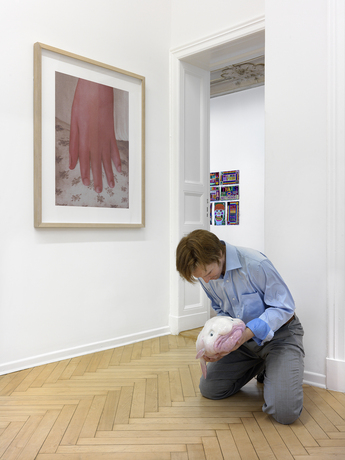-
From Current Issue
-
- Editor’s Letter Fire in the Heart
- Reviews I Gusti Ayu Kadek Murniasih
- Reviews 11th Seoul Mediacity Biennale: “One Escape at a Time”
- Dispatch Networked China
- One on One Monira Al Qadiri on Yukio Mishima
- Essays The rise of independent art spaces in pandemic-era Shanghai
- Features Tuan Andrew Nguyen
- Table of Contents
- Web Exclusives
- Archive
- Subscribe

R
E
V N
E
X
T
“Body as pleasure. Body as machine. Body longing, always longing. Hungry body, filthy body.” That was the premise formulated by artist and curator Del Kathryn Barton for the group show “Mad Love”at Berlin’s Arndt Art Agency. The Australian comtemporary art show focused on nine artistic approaches to the physical and emotional boundaries of the body, featuring intuitive works surrounding the gendered body and digging into the ideas of identity and connections to the geographic mass in relation to Australia’s complex indigenous culture.
Opposite the entrance to the space, viewers found an emotional yet bizarre scene: a man made of fiberglass and dressed in office clothes kneeling on the floor, holding a strange gelatinous mass. Upon closer examination, the pale object in his hands is revealed to be a sculpted blobfish, a nearly extinct creature that lives in the seas south of Australia. Patricia Piccinini’s hyperrealistic Eulogy (2011) shows us average or unsightly bodies, highlighting their unlikely relation to one another in real life. Her other work, The Osculating Curve (2016), is a seemingly ill-assembled female body missing its head and most of its limbs. Leaning back on a mirror-clad plinth, the pregnant belly top is decorated with human hair and six small, oval shapes with lips pointing in every direction—either the result of a horrifying experiment or an otherworldly take on the condition of fertility.
Piccini’s ruminations on real versus imagined bodies are further reflected in photo media artist Pat Brassington’s pigment prints, which, dispersed throughout the show, focus on the sensual landscape of limbs and their reinterpretation in the process of collage. Purr (2005), a close-up of a pink hand’s fingertips caressing an out-of-style fabric, gives its objects a tangible quality, while the print Bayonet (2013) features Brassington’s intricate image manipulation: The black-and-white work presents a blurred snapshot of hips and legs, with a lightbulb hanging between them. The bulb’s odd placement, as if growing out of the body as a third limb, is reminiscent of early imaginations of automated bodies. With viewers moving back and forth between her works to find a connection from one limb to another, Brassington’s images humorously accompany the audience’s pursuit of physical completeness —a puzzle that can only be finished in the viewer’s imagination.
PAUL YORE, Everything Is Fucked, 2016, wool needlepoint, 30.5 × 48.5 cm. Courtesy Arndt Art Agency, Berlin.
More direct representations of sexuality are examined in Melbourne artist Paul Yore’s patchwork textiles works, with the spotlight on his carnal universe of phalluses, insects and pop culture symbols within dense, psychedelic patterns. His sewn anti-slogans, such as Everything Is Fucked (2016), reflect the artist’s controversial stance on gender politics and media oversaturation. Taking on Yore’s gaudy palette is artist-curator Barton herself: Her paintings, one of them titled Hard Wet (2017), depict dreamt-up “she-beasts,” female figures suspended in prismatic space that have an almost hallucinatory effect on their audience.
Sri Lanka-born Australian artist Ramesh Mario Nithiyendran’s ceramic self-portrait sculptures—with the earthenware’s flawed, tangible quality and inconspicuous wealth of detail—are the most corporeal works in the exhibition. Yoking Hindu and Christian culture, Nithiyendran’s distorted Head (2017), partly godlike and partly a self-representation with the artist’s first name sculpted on its ceramic skin, lures viewers with its inviting yet unsettling crooked smile. The auratic space of Headundermines Dale Frank’s flashy, mixed-media amalgams of horror clown and evil animal masks glued onto framed panels.
Elsewhere in the show, two artists concentrate on the body as land and geographical identity, unpacking Australia’s difficult colonial past and its current issues with First Nation cultures. The first is Mirdidingkingathi Juwarnda Sally Gabori, the contemporary painter of Kaiadilt descent who passed away in 2015, whose signature painterly abstractions of topographies rooted in her personal history were featured. Thundi (2010), a painting highlighting its landscape in tonal contrasts from jet black to luminous white, depicts her father’s country, Thundi (or Thunduyi). Nearby, Brook Andrew’s prints from his “Gun-metal Grey” series (2007) directly confronts Australia’s troubled history. His ethnographic photographs on metallic foil ominously survey the room, propelling viewers to reconsider a historically shaped discourse of nationality and its present day impact.
Visitors to Arndt Art Agency were prompted to reevaluate their sense of the palpable and corporeal in relation to the fantastical with the show’s dreamy female creatures, carnal color explosions and poetic meditations on the earth as body. With these eclectic visions of past and present, “Mad Love” provided a glimpse into contemporary Australian culture for an audience on the other side of the globe. However, while “madness” loomed large in many of the selected artworks, viewers were left wondering where the “love” was.
“Mad Love” is on view at Arndt Art Agency, Berlin, until September 29, 2017.
To read more of ArtAsiaPacific’s articles, visit our Digital Library.











